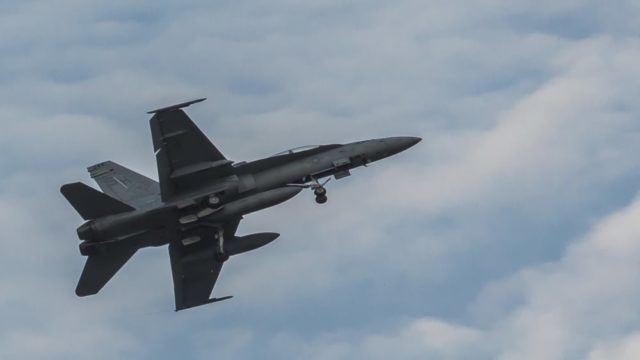
Oak trees ‘fried’: Cleanup at Beaufort fighter jet crash site called an ‘extreme operation’ An F/A-18D Hornet from Marine Fighter Attack Training Squadron 101 prepares to make a field carrier landing Oct. 13, 2015 aboard Marine Corps Air Station Beaufort. (Lance Cpl. Jonah Lovy/U.S. Marine Corps)
An explosion from a Marine Corps F/A-18D Hornet crash at Coosaw Plantation last week “fried” several live oak trees that had stood for a century or more and contaminated a large area with jet fuel that a specialized team from the U.S. Navy is now removing and replacing.
The jet fighter, which crashed near Halfmoon Island just north of Marine Corps Air Station Beaufort on March 3, was attached to the 2nd Marine Aircraft Wing.
Members of the Jacksonville, Florida-based Navy Region Southeast On-Scene Coordinator program arrived on scene March 4 to assist in recovering aircraft wreckage and evaluating the site for environmental and public health impacts. The team, which spent the past five days removing the wreckage and impacted soil at the site, is nearing the end of the environmental cleanup.
“We will remove soil contaminated with jet fuel from the aircraft mishap site until test results show we have cleaned up the crash site to state and federal standards,” Navy On-Scene Coordinator John Baxter said in a new release. “Next we will bring in clean backfill (soil) to restore the impacted property.”
The crash impacted a single parcel of land and no cleanup actions were required at neighboring properties, Baxter said. The land is owned by the family of former South Carolina Gov. Mark Sanford.
Sanford told the Beaufort Gazette and Island Packet on Thursday that the cleanup involved digging a massive hole at the site of impact to remove soil that was contaminated by jet fuel.
“It’s been an extreme operation as it might be expected with a plane that explodes carrying 2,000 gallons of fuel,” Sanford said.
Cleanup has included bringing in environmental specialists to look at very old live oak trees so that the team could determine if those impacted by contamination and fire could be saved, the Navy said.
The fire burned about 40 acres, Sanford said. And five large live oak trees that Sanford said were at least 100 years old were incinerated from an explosion that followed the crash.
“It fried ’em,” he said. “It was like a giant toaster.”
The trees, which were left standing, had to be knocked down and removed. Fire also damaged additional pines and oaks located further from the crash site, Sanford said. His father’s grave site, which has a granite headstone, is located under the trees that were destroyed but was not damaged.
While family members are saddened by the loss of towering oaks that their father loved, they were grateful to see the two pilots walk away alive after ejecting before the crash. Sanford’s sister and brother both raced to the scene.
“It’s a very significant place to our family,” Sanford said. “That’s not the Navy’s fault. It just is what it is.”
Baxter, the Navy’s on-scene coordinator, called the loss of the trees “very unfortunate.”
“We are very thankful that no one was injured on the ground or the aircraft,” Baxter said, “and for the support we received from the local community, as we assess the damage to the property and conduct the environmental cleanup.”
The work is expected to be complete by the end of next week, the Navy said.
Meanwhile, an Aviation Mishap Board has been convened to investigate why the 28-year-old, $37 million jet, which was nearing the end of its service life, went down. Its work is expected to be done April 2, but it could take a few months before the final report is published.
___
(c) 2022 The Island Packet Distributed by Tribune Content Agency, LLC




